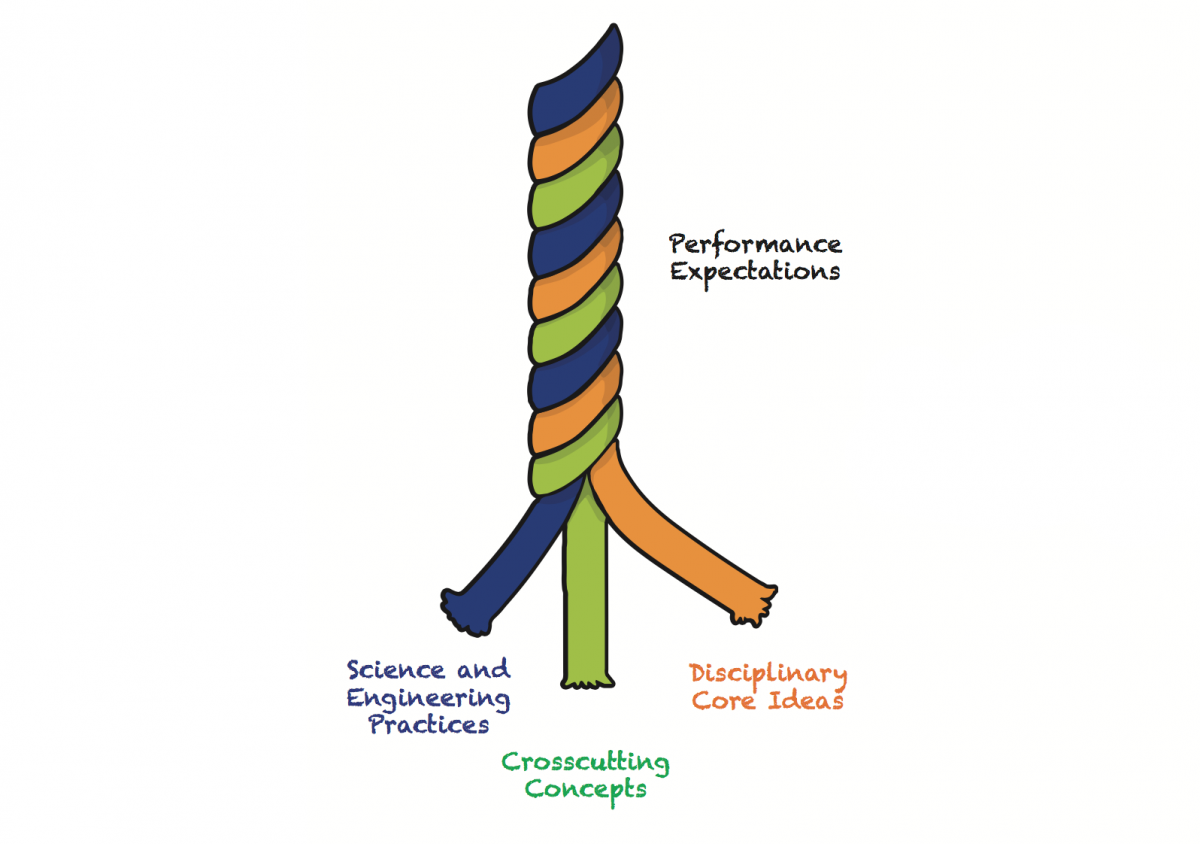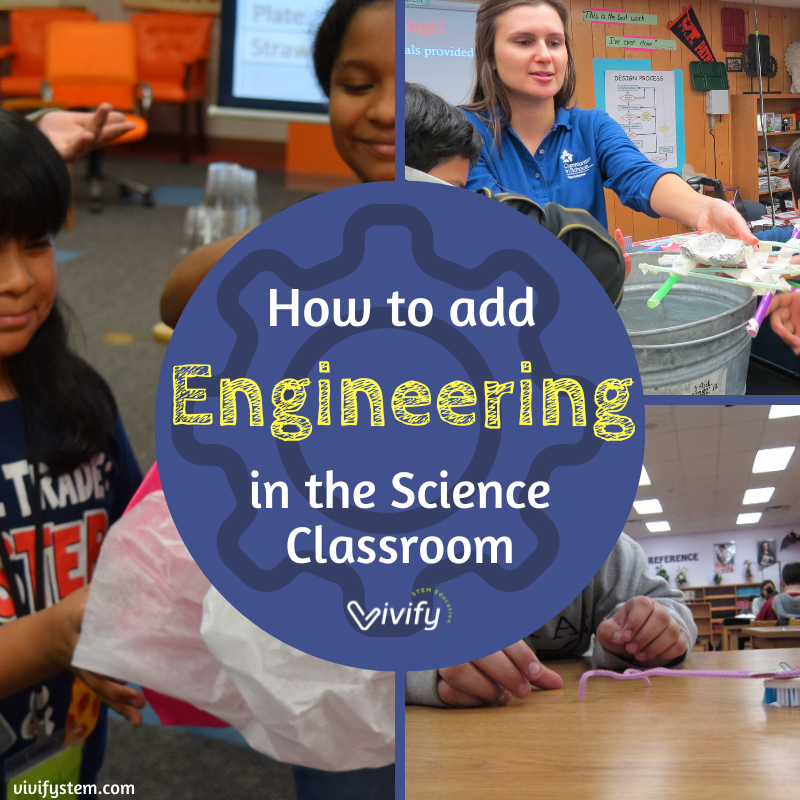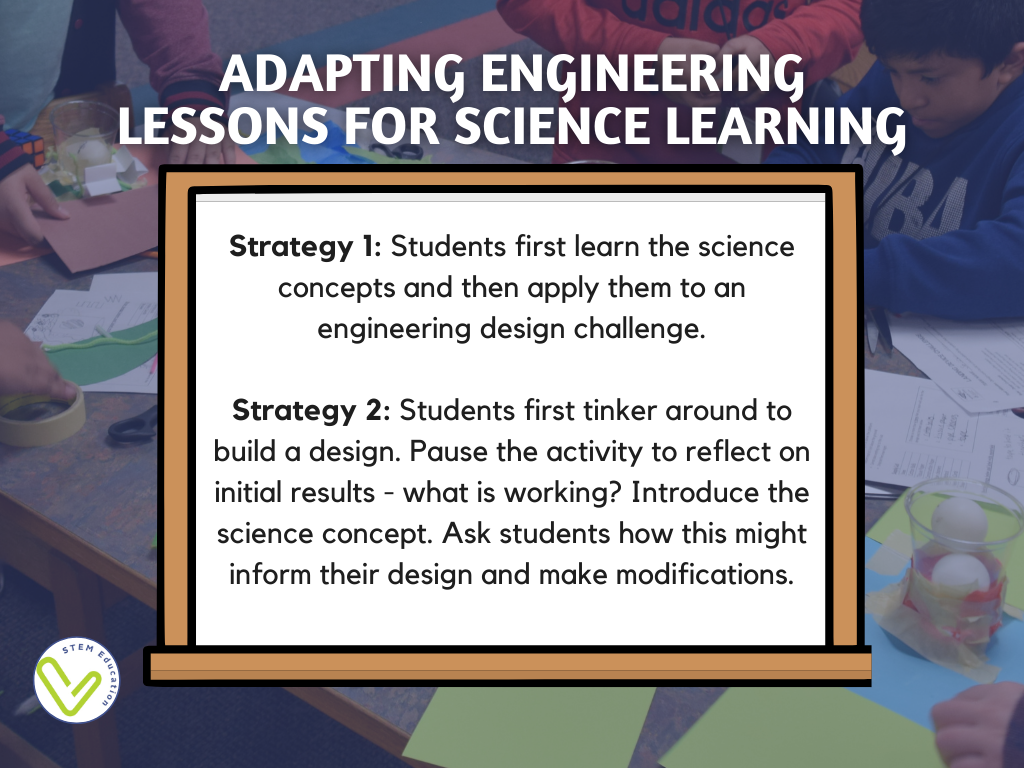Engineering in the Science Classroom
Post Natasha Wilkerson
Originally Posted: November 22, 2022
Updated: April 2024
Help! I am a science teacher, and I am trying to figure out how to integrate engineering in my classroom! Which engineering challenges best support science learning? What about engineering practices? Why should I even integrate engineering into science instruction?
Using the Next Generation Science Standards (NGSS) as a guide, we break down the best ways to add engineering design to enhance science in your elementary and middle school classroom. It’s a big topic to tackle, but we try to provide simple strategies, recommended lessons, and more resources to get you started.
Overview of the NGSS
If you are a K-12 science teacher in the United States, most likely you are following or have state standards influenced by the Next Generate Science Standards (NGSS). Did you know the NGSS was a fairly recent overhaul of K-12 science education in the United States? The National Science Teachers Association (NSTA) provides a great overview of the history here.
A brief history of NGSS
2011: A Framework for K-12 Science Education was developed in response to alarming reports of Americans’ declining scientific literacy. This framework outlines a set of expectations for students in science and engineering in grades K-12.
2013: NGSS was developed from that framework in collaboration with 26 states and several organizations.
So far, 20 states and the District of Columbia have adopted the NGSS. An additional 24 states have developed their own science standards based on the framework.
Three Dimensions of Science Learning
NGSS and the Framework move away from a traditional way of teaching science that was focused on rote memorization. Instead, they adopt a three-dimensional approach that involves students not only understanding science concepts, but using those concepts to answer questions and solve problems.
Disciplinary Core Ideas (DCIs): This is what students should know and covers 4 content areas:
Physical Science (PS)
Life Science (LS)
Earth and Space Science (ESS)
Engineering, Technology, and Applications of Science (ETS)
Science and Engineering Practices (SEPs): These practices are how students will learn science and engineering. By actually “doing” science and engineering, students will become more engaged, deepen their understanding of core ideas, and gain an appreciation of the nature of science and engineering. To read more about the difference between science and engineering click here. Practices include:
Asking questions (science) / Defining problems (engineering)
Developing and using models
Planning and carrying out investigations
Analyzing and interpreting data
Using mathematical and computation thinking
Construction Explanations (science) / Designing Solutions (engineering)
Engaging in Arguments from evidence
Obtaining and evaluating and communicating information
Crosscutting Concepts: These are big ideas that cross across multiple subject areas and help students organize thinking.
Patterns
Cause & Effect
Scale, Proportion, and Quantity
Systems & systems models
Energy & matter
Structure & Function
Stability & Change
Performance Expectations: The NGSS then combines each of these dimensions to create performance expectations for each grade level. For example, in fifth grade physical science:
5-PS1-1: Students will develop a model to describe (practice) that matter is made of particles (core idea) too small to be seen (crosscutting concept).
Below are some helpful graphics that explain these three dimensions:


Where Does Engineering Fit?
The NGSS strongly advocates for the integration of engineering into the science classroom and raises “engineering design to the same level as scientific inquiry” (NGSS Lead States, Appendix I). They argue that having a foundation in engineering allows students to “better engage in and aspire to solve the major societal and environmental challenges”.
Disciplinary Core Ideas for Engineering
The following are the core ideas in the Engineering, Technology, and the Application of Science domain. Click each to see how these progress across K - 12 grades.
ETS1.A: Defining and Delimiting Engineering Problems: Students can state the problem in terms of criteria for success and constraints or limits.
ETS1.B: Developing Possible Solutions: Students can generate a number of different solutions and evaluate them based on constraints and criteria.
ETS1.C: Optimizing the Design Solution: Students systematically test and refine a design and consider trade-offs between features.
Sounds a lot like the engineering design process! NGSS also notes that this doesn’t need to follow a specific order: students can redefine the problem and generate a solution at any stage when an idea isn’t working!
Engineering Practices in the NGSS
Did you notice that the DCIs for engineering sound like engineering practices? For example, ETS1.A Defining and Delimiting Engineering Problems is identical to the first science and engineering practice (Asking questions / Defining problems). This goes back to how NGSS views engineering: as the application of science. All engineering DCIs are written with verbs (e.g. define) while the rest of the DCIs for the science content areas are nouns like “forces and motion.”
In fact, some argue that educators can ignore these 3 engineering DCIs as they are already captured in the engineering practices (Click here for paper). Instead, educators should recognize the differences between science and engineering within each practice. The authors provide a great comparison shown below (click here for original source).
What do you think? Is engineering just the application of science? Or does engineering have its own set of concepts that are appropriate for K-12 students? We wrote a blog post earlier this year on the Framework for P-12 Engineering Learning that argues how engineering education needs to be taught as a separate discipline from science. Using engineering just as a vehicle for science leads to the misrepresentation of engineering. Click here for our post.
Engineering Design in Performance Expectations
Now let’s get to the practical part - how do you integrate engineering in your classroom? We recommend focusing on the performance expectations that involve engineering. Performance expectations are assessable statements of what students should know and be able to do.
The table above features all the NGSS performance expectations that incorporate engineering. The far right column “Engineering” are performance expectations that relate to engineering practices only and do not have a science connection. For example:
3-5-ETS1-1: Define a simple design problem reflecting a need or a want that includes specified criteria for success and constraints on materials, time, or cost.
These are an elaboration on the engineering DCIs discussed and have no science connection. The other columns are using engineering as an application of scientific concepts. For example:
MS-PS2-1: Apply Newton’s Third Law to design a solution to a problem involving the motion of two colliding objects.
3-ESS3-1: Make a claim about the merit of a design solution that reduces the impacts of a weather-related hazard.
MS-LS2-5: Evaluate competing design solutions for maintaining biodiversity and ecosystem services.
In these examples, the expectation is explicitly calling for the use of an engineering design practice through the use of scientific knowledge. Engineering is an application of scientific knowledge. For science teachers who have limited time, I would plan engineering-based lessons around the first 3 columns as they explicitly connect to a science concept I am needing to cover. The engineering-specific performance expectations can help me further scaffold the lesson.
Click here for a document that provides the full description of each performance expectation.
NGSS Aligned Engineering Lessons
In our own teaching experiences, we have noticed that sometimes we get so caught up in the fun of design activities that students miss the entire point! If the goal of the activity is to teach science, we must recognize that a teacher is instrumental in supporting students learning and applying science concepts.
If you click on Vivify’s Curriculum Map and scroll down to Stage 2 Lessons, you will see activities by content area (Earth Science, Life Science, etc). Each of these can be tied back to a science content area, but the implementation and role of the teacher is critical.
For example, let’s take MS-PS2-1 standard. We task students with designing a device to keep an egg from cracking. We connect this to the injuries faced by football players during impact on the field. Here is how this likely goes:
Students look at the materials and draw a design idea.
Students pick materials that they intuitively know are “softer” like cotton balls.
Students build a device and test it. Either it works - time to celebrate! - or the egg cracks. What happens in the re-design? They stuff more cotton balls into the casing in hopes it prevents cracking.
Reflection generally focuses on the challenges they faced during testing and the materials selected.
Did these activities result in a deeper understanding of Newton’s Third Law? Did students actively apply science to their design?
Without our guidance and careful planning of the lesson, the answer is definitely not! A design challenge alone will not promote scientific ideas. Discovery learning is not real. Students will not suddenly discover concepts of momentum and that force is equal to mass x acceleration. If they did, well then you have the next Einstein in your class!
Researchers have found that half of engineering design-based science lessons did not tie into any science concepts and only 11% promoted understanding of science concepts! - Pleasants, Tank, Olson (2021)
Adapting Engineering Lessons for Science Learning
So then how can we use engineering to teach science? We will dive deeper into this topic, but some strategies include:
Using the engineering design challenge after students have already developed some understanding of the concept.
Allowing students to tinker with a design and then pause the activity to reflect on initial results - what is working? Introduce the science concept and ask students how this might inform their design.
The goal of most Vivify STEM lessons is to teach engineering practices and habits of mind. Click here for our original post on the 3 Stage of STEM and intended learning outcomes. However, we are becoming more intentional in the teaching of science content in recent lessons:
More on this topic to come! But, I don’t think that engineering design should only be used as a way to teach science. As I described in this blog post, engineering for the sake of engineering is important. Engineering in K-12 can promote important engineering habits of mind and practices that are completely separate from science learning. Our egg drop challenge activities above helped students develop various engineering practices.
Bottom line: be clear as to the goal of your engineering lesson.
Do you want to promote science concepts? Are you focused on engineering design such as material selection or problem definition? Maybe the goal is on social skills like teamwork? Or maybe you just want a fun and memorable experience. All are important goals, but to achieve them, we need to make them clear!








